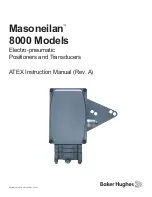
Operational Theory
2000 XTC
instrument for analyzing other gas mixtures. Generally, the user must be
able to calibrate the instrument with a gas containing the host gas and a
known concentration of the impurity or gas to be analyzed. At a
minimum, a zero gas and a mixture containing approximately 70-100%
of the species to be analyzed on the range of interest should be provided
in order to properly calibrate this instrument.
Figure 2-1 shows a cross section of the sensor used in the 2000 XTC. A
resistor is mounted on a heated membrane to which the sample gas is
exposed. This resistor is used to both heat and measure the temperature of the
membrane. A second resistor is fabricated directly on the silicon and is used
to compensate for changes in the ambient temperature. Depending on the
sample gas density, exposing the sensor to the gas will either increase the
membrane temperature or decrease or the measuring resistor temperature.
Implementing each of the two resistors in the analog signal conditioning
stages enables the null point of the circuit to be directly related to the thermal
conductivity of the sample gas.
Figure 2-1: Thermal Conductivity Sensor
During calibration, the analog signal is balanced for the zero gas at
one end of the measurement range, and span gas at the other end. The
resulting electrical signal is fed to a microprocessor which linearizes the
output based on data programmed at the factory. An E-to-I converter
produces an isolated 4–20 mA DC current output spanning the analysis
range.
Teledyne Analytical Instruments
6
















































